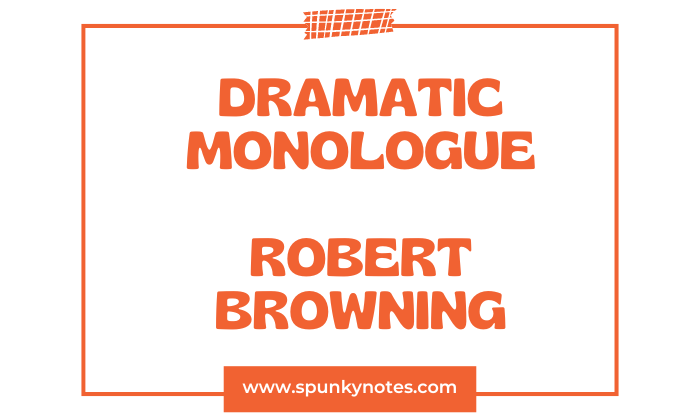
Q. How does Robert Browning use the dramatic monologue format to explore the psychology of his characters?
A dramatic monologue is a type of poetry where a single speaker addresses a silent audience, revealing his thoughts and feelings. This form allows poets to dive deep into the character’s mind, showing their perspective.
Robert Browning is famous for popularizing this form during the Victorian era. In his monologues, characters often reveal more about themselves than they intend to, allowing readers to understand their deeper motivations and conflicts.
The audience gets to hear the speaker’s voice directly, making the narrative more intimate and engaging.
Browning’s monologues are not just stories; they are psychological portraits that unfold through the speech of the protagonist, providing insights into human behavior.
Revealing the Inner Lives
Robert Browning’s dramatic monologues are particularly effective for exploring the inner lives of characters. Through these monologues, Browning allows the speaker to reveal their personal thoughts and feelings directly to the audience.
This direct revelation helps uncover the underlying motivations and conflicts of the characters.
In these monologues, the speakers often unwittingly expose their flaws and weaknesses. For example, in “My Last Duchess,” the Duke’s talk about his late wife subtly reveals his controlling nature and obsession with power.
Similarly, in “Porphyria’s Lover,” the speaker’s calm description of his actions to preserve a moment of love by killing Porphyria lays bare his disturbed mental state.
1- Fra Lippo Lippi
In Robert Browning’s “Fra Lippo Lippi,” the dramatic monologue format allows the protagonist to speak directly to the audience, sharing his personal views and experiences in his own words.
This method is effective in revealing Lippo Lippi’s internal conflicts and his perspective on art. Lippo Lippi discusses his artistic philosophy by stating,
We’re made so that we love
First when we see them painted, things we have passed
Perhaps a hundred times nor cared to see.
Here, he argues that art should reflect everyday life and human beauty, highlighting the often overlooked aspects of the world. This line emphasizes his belief that art has the power to make ordinary scenes captivating and meaningful.
Throughout the monologue, Lippo Lippi details his interactions with the church, which expects art to serve primarily religious purposes.
He expresses frustration with these restrictions, advocating for a broader view of art’s role. His dialogue reveals a deep commitment to portraying the truth as he sees it, rather than conforming to the strict religious narratives preferred by the church.
The direct communication in the dramatic monologue brings the audience closer to Lippo Lippi’s experiences, allowing us to understand his passion for art and his struggle for creative freedom.
This connection is key to appreciating the poem’s exploration of individual expression versus institutional constraints. Through this format, Browning effectively portrays Lippo Lippi as an individual caught between his duties and his artistic desires.
2- The Last Ride Together
“The Last Ride Together” by Robert Browning is a dramatic monologue that features a man speaking to his former lover who remains silent. In the poem, he reflects on their final moments together after she has ended their relationship.
The format of a dramatic monologue allows us to hear only the speaker’s thoughts. He uses this time to talk about their past and tries to find peace in their last ride together. This setup helps us see deeply into his emotions and thoughts.
In this type of poem, the speaker often reveals more about himself than he intends. Through his speech, we learn about his struggle to accept the relationship’s end. He views their last ride as a significant, meaningful experience.
The dramatic monologue focuses entirely on the speaker’s inner world. We get a clear picture of his feelings as he discusses his past and current pain. His words show his efforts to cope with the breakup and to appreciate the good memories they shared.
3- My Last Duchess
Robert Browning’s poem “My Last Duchess” is a classic example of a dramatic monologue. In the poem, the Duke of Ferrara is speaking to an envoy from a count whose daughter he hopes to marry.
As they stand before the portrait of the Duke’s previous wife, the Duchess, he begins to reveal details about her behavior and his dissatisfaction with her.
The Duke describes how the Duchess was too friendly and how her behavior displeased him. He subtly implies that he had her killed because she did not live up to his expectations:
I gave commands;
Then all smiles stopped together.
This line chillingly suggests his role in her demise without explicitly stating it. The dramatic monologue format allows the Duke to express his thoughts directly to the envoy, and indirectly to the reader.
It reveals his controlling and jealous nature. Through his speech, we see that the Duke values obedience and views his wife as an object to be controlled.
The poem’s structure, where the Duke is the only one speaking, helps highlight his authoritative personality and the power imbalance in his relationships.
It also allows us to see the irony in his words—he presents himself as a reasonable husband, while his actions suggest otherwise.
4- Porphyria’s Lover
In “Porphyria’s Lover” by Robert Browning, the dramatic monologue format provides a clear window into the speaker’s thoughts and actions.
Throughout the poem, the speaker recounts how Porphyria came to visit him during a storm, describing the weather as,
The rain set early in tonight,
The sullen wind was soon awake.
This sets a gloomy and tense atmosphere right from the beginning. As the evening progresses, Porphyria makes herself comfortable and declares her love for him, an action he describes:
She put my arm about her waist,
And made her smooth white shoulder bare.
These details indicate her affection and vulnerability. However, the speaker’s response to her actions reveals his darker intentions. He decides to preserve the moment by killing her, using her hair as the tool:
I found
A thing to do, and all her hair
In one long yellow string I wound
Three times her little throat around,
And strangled her.
The dramatic monologue allows the speaker to justify his actions to the audience, claiming,
No pain felt she;
I am quite sure she felt no pain,
It suggests he believes that his act was merciful or even desired. After committing the act, he spends the rest of the night with her body, describing the unsettling calmness of the scene:
Thus we sit together now,
And all night long we have not stirred,
Yet God has not said a word!
This indicates his delusional belief that his actions were not wrong and that there have been no consequences.
Through this monologue, Browning effectively reveals the speaker’s disturbed psychological state, his misconceptions about love and possession, and his moral disorientation.
The format of the monologue draws the reader directly into the speaker’s mind, showcasing his twisted reasoning and the chilling serenity he feels after his horrific act.

